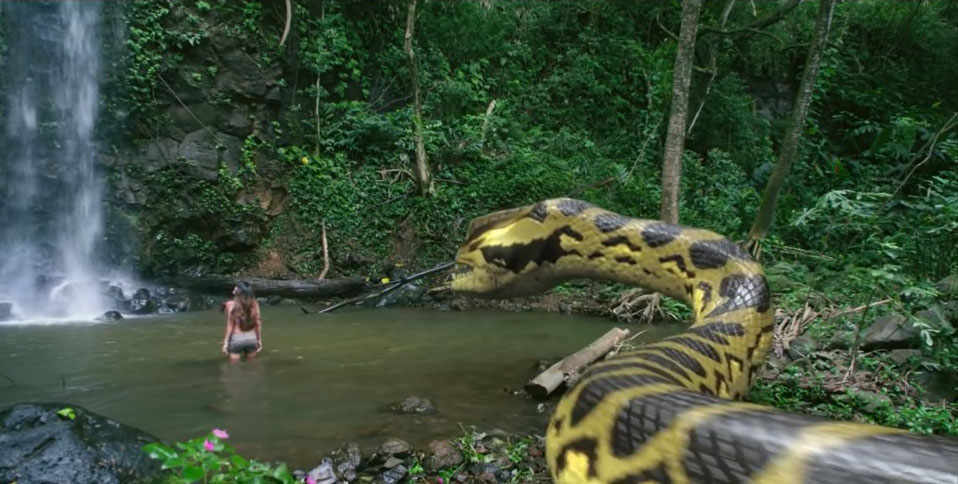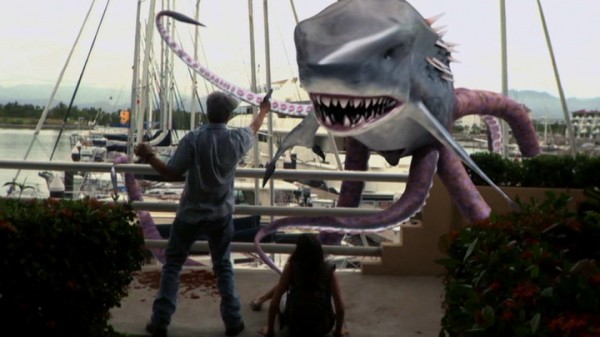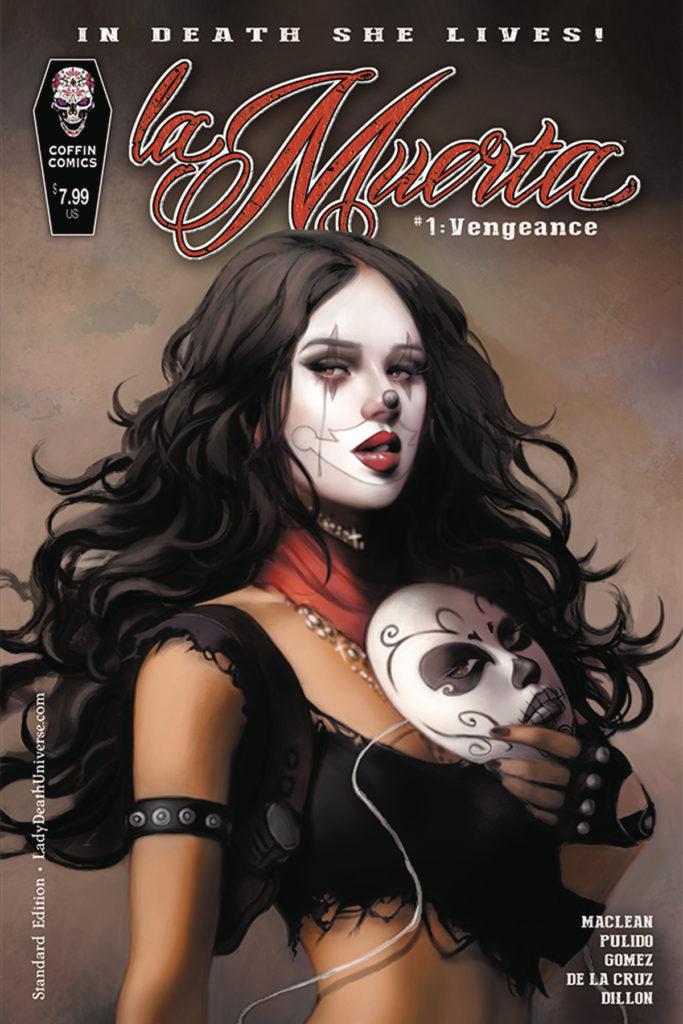
ENTREVISTA A MIKE MACLEAN, GUIONISTA DE PIRAÑACONDA Y SHARKTOPUS
(English below)
La historia del cine está plagada de monstruos gigantes asesinos que amenazan a la humanidad. El ejemplo más clásico es el de King Kong (Merian C. Cooper & Ernest B. Schoedsack, 1933) con su icónica imagen del enorme simio subido al Empire State. Unos años más tarde, en 1954, vendría Godzilla, criatura llevada al cine por Ishirô Honda y que serviría de inspiración para muchos otros grandes creadores (Jack Arnold, Don Chaffey, Joe Dante, Steven Spielberg, Guillermo del Toro, Bong Joon-ho, Matt Reeves, Nacho Vigalondo…). Actualmente, este catastrófico subgénero sigue de moda, y de hecho es uno de los más prolíficos. Productoras como The Asylum o SyFy nos ofrecen anualmente decenas de títulos de lo más amenazantes y terroríficos, como Lavalántula, Megatiburón contra Crocosaurio, Megatiburón contra Pulpo Gigante, Castores zombies, Komodo contra Cobra o El ataque del tiburón de seis cabezas. Pero si hay algún film que destaca entre todos ellos, es Pirañaconda (Jim Wynorski, 2012), un clásico instantáneo interpretado por Michael Madsen y Rachel Hunter y producido por el gran Roger Corman. El creador de este híbrido entre una piraña y una anaconda que tiene aterrorizados a los habitantes de una isla remota, la cabeza pensante que firma su guión, es Mike MacLean, también responsable de los guiones de otros grandes títulos como Sharktopus, Dinocroc vs. Supergator o Attack of the 50 Foot Cheerleader. Hemos tenido el privilegio de hablar con él y de que respondiese a algunas preguntas sobre uno de nuestros subgéneros favoritos.
– Pirañaconda, Sharktopus, Dinocroc… todas tus criaturas son híbridos monstruosos muy enfadados con ganas de destruir cosas. ¿De dónde viene tu afición por este género? ¿Cuáles son tus referentes, tu inspiración?
Como niño criado en los años 70 y 80, estaba pegado a la televisión cada sábado por la mañana. No teníamos televisión por cable, pero el canal local emitía películas de Godzilla, King Kong y de los monstruos de la Universal, y también muchas de Roger Corman. Son recuerdos muy preciados y especiales.
– ¿Cómo es el proceso de creación de un guión como el de Pirañaconda? ¿Cuáles son tus métodos de trabajo?
En el caso de Pirañaconda y Sharktopus me dieron los estrambóticos títulos y la premisa básica de la historia. Entonces, escribí una sinopsis, detallando ideas para el argumento y personajes. Cuando aceptaron la sinopsis, preparé tres borradores. Cada uno de ellos fue revisado por Mr. Corman y su equipo en New Horizons, quienes me hacían apuntes para que lo revisase.
– Has trabajado con SyFy que, como The Asylum y otras productoras, apuestan por los monstruos gigantescos. ¿Cómo se involucra uno en un proyecto así? ¿Cómo es colaborar con ellos?
Alguien del equipo de Roger Corman descubrió una de mis historias en la antología Best American Mysteries y se puso en contacto conmigo. Entonces, me contrataron para que escribiese un thriller bastante duro. Nunca llegaron a producir el guión, pero les gustó cómo escribía. Así que, cuando necesitaron un guionista para ayudarles con Dinocroc vs Supergator, me llamaron a mí. Debí hacerlo bien, porque después me volvieron a contratar para escribir Sharktopus y luego Pirañaconda.

– El productor ejecutivo de Pirañaconda y Sharktopus es el gran Roger Corman. ¿Has tenido oportunidad de conocerlo? ¿Nos puedes contar algo de él?
Mientras trabajaba en Sharktopus, Roger y su esposa me llevaron a Puerto Vallarta para comprobar algunas posibles localizaciones de rodaje. Disfrutamos de una comida increíble y bebimos cócteles de frutas mientras conversábamos sobre monstruos. Tengo que admitir que me flipé un poco hablando sobre la carrera cinematográfica de Roger, haciéndole miles de preguntas. Fue fantástico.
– Los films que has escrito han sido protagonizados por grandes estrellas como Eric Roberts, del que me declaro el fan número 1, Michael Madsen o Rachel Hunter. ¿Has tenido trato con alguna de estas estrellas? ¿Cómo son personalmente? ¿Cómo afrontan la grabación de estos proyectos?
Me encanta escribir guiones, pero no es un trabajo muy glamuroso. Me paso el 99% del tiempo delante del ordenador, aporreando el teclado. Por desgracia, nunca tuve la oportunidad de conocer a ninguna estrella.

– Además de guionista, eres escritor de comics y novelista. Háblanos un poco de tu trabajo en esas disciplinas.
Actualmente trabajo para Coffin Comics, coescribiendo todas sus obras junto al icono del comic independiente Brian Pulido. Hasta ahora, tuve que escribir Lady Death, Hellwitch, Zack the Zombie Exterminator, y La Muerta, una vigilante americana-mexicana. Es una pasada.
Algunas de mis historias sobre crímenes han sido publicadas como parte de otros libros, pero aún tengo que publicar una novela. Algún día.
– ¿Cuáles son tus proyectos futuros? ¿Podremos disfrutar próximamente de algún film catastrófico firmado por ti?
Ahora mismo no tengo ningún proyecto de película. Pero Coffin Comics está haciendo una campaña en kickstarter para su última novela gráfica Lady Death: Necrotic Genesis. Si te gustan las doncellas sexys con espadas, échale un vistazo.

—————————— x ——————————
The history of cinema is plagued with giant killer monsters which threaten humanity. The classic example is King Kong (Merian C. Cooper & Ernest B. Schoedsack, 1933) with his iconic image of the enormous ape on the top of the Empire State. Some years later, in 1954, Godzilla would appear, a creature brought to the cinema by Ishirô Honda and served as the inspiration for many other great creators (Jack Arnold, Don Chaffey, Joe Dante, Steven Spielberg, Guillermo del Toro, Bong Joon-ho, Matt Reeves, Nacho Vigalondo…). Currently, this catastrophic sub-genre is still popular and, in fact, it’s one of the most prolific ones. Production companies, like The Asylum or SyFy, annually produce dozens of threatening and terrifying titles such as Lavalantula, Mega Shark vs Crocosaurus, Mega Shark versus Giant Octopus, Zombeavers, Komodo vs Cobra or 6-Headed Shark Attack. But if there is a film that stands out between all of them, it is Piranhaconda (Jim Wynorski, 2012), an instant classic interpreted by Michael Madsen and produced by the great Roger Corman. The creator of that hybrid between a piranha and anaconda that has terrorised the inhabitants of a remote island, the brain behind who signed the script, is Mike MacLean, also responsible for the scripts of other great titles such as Sharktopus, Dinocroc vs. Supergator or Attack of the 50 Foot Cheerleader. We had the privilege to connect with him and he answered some of our questions about one of our favourite sub-genres.
– All your creatures are very angry hybrid monsters wanting to destroy things. Where does your interest for this genre come from ? What are your references, your inspiration ?
As a kid in the ‘70s and ‘80s, I was glued to the television watching monster movies every Saturday morning. We didn’t have cable, but our local station played Godzilla, King Kong, The Universal Monsters, and a ton of Roger Corman movies. Those are some very fond memories.
– What is the process of creating a script like the one from Piranhaconda ? What are your work methods?
In the case of Piranhaconda and Sharktopus I was given the outrageous titles and the basic premise of the story. I would then write a synopsis, detailing ideas for the plot and characters. Once the synopsis was accepted, I’d punch up three drafts. Each one was reviewed by Mr. Corman and his staff at New Horizons who would give me notes for my revision.
– You have worked with SyFy which, like The Asylum and other production companies, banking on the giant monsters. How do you get involved in a project like this ? What is it like to collaborate with them?
Someone at Roger Corman’s company discovered one of my stories in the Best American Mysteries anthology and reached out to me. The company hired me to write a hard-boiled crime thriller. They never produced that script, but they liked how I wrote. So, when they needed a screenwriter to help out with Dinocroc vs. Supergator, they called me up. I must have done okay on that script because they later hired me to write Sharktopus then Pirañaconda.
– The Executive Producer of Piranhaconda and Sharktopus is the great Roger Corman. Did you have the chance to meet him? Can you tell us something about him?
While working on Sharktopus, Roger and his wife Julie flew me down to Puerto Vallarta to check out some possible shooting locations. We had an amazing meal and drank fruity cocktails while chatting about monsters. I admit to geeking out over Roger’s film career, asking him a thousand questions. It was awesome.
– The films that you wrote have been interpreted by big starts like Eric Roberts, who I’m fan number one of, Michael Madsen or Rachel Hunter. Have you had any contact with these stars? How are they in person ? How do they face the filming of these projects ?
I absolutely love writing screenplays, but it is not a glamours job. I spend 99% of the time alone in front of a laptop, pounding the keyboard. Unfortunately, I never got a chance to meet any stars.
– In addition to being a script writer, you are a comic writer, and novelist. Talk to us about your work in those disciplines.
Currently, I work for Coffin Comics, co-writing all of their properties with independent comic icon Brian Pulido. So far, I’ve gotten to write Lady Death, Hellwitch, Zack the Zombie Exterminator, and La Muerta, a Mexican American vigilante. It’s an absolute blast.
Several of my crime fiction stories have been published in books, but I have yet to publish a novel. Some day.
– What are your future projects? Will we be able to enjoy soon some disaster film written by you? I don’t have any movies lined up right now. But currently, Coffin Comics is running a kickstarter campaign for their latest graphic novel Lady Death: Necrotic Genesis. If you like sexy, sword-wielding battle maidens, check it out.
